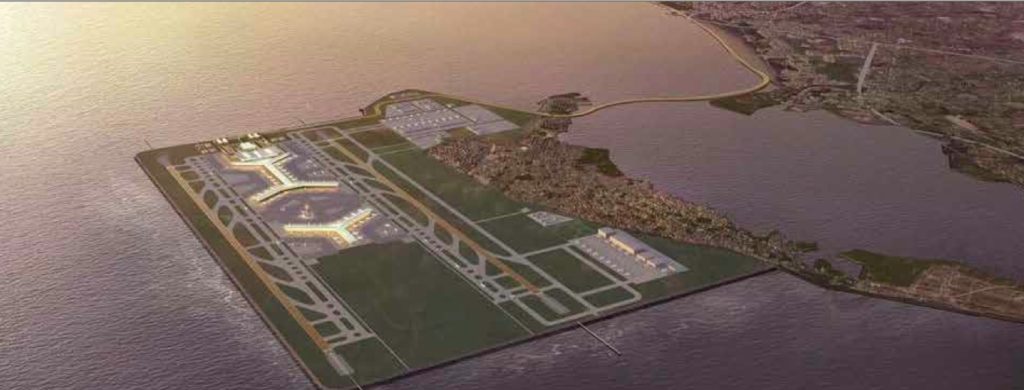
The Provincial Government of Cavite’s proposed Sangley Point International Airport. This rendering shows the airport with two runways and passenger terminals that can serve 75 million passengers annually by 2025. CONTRIBUTED
The Province of Cavite proposed a $9.3-billion airport project in Sangley Point that would position the site of a former United States naval base into a near-future alternative air hub to the cramped Ninoy Aquino International Airport (Naia) in Manila.
The province, as lead proponent, is using a unique and potentially strategic government-to-government approach that also aims to address environmental issues in the waters off its coastal towns.
It has so far lured investment commitments from local businessmen and Chinese state-owned enterprises, including a unit of financial giant Citic Group, an adviser told the Inquirer.
It comes as the latest attempt at a solution to Naia’s long-running congestion problems, where the private sector has been playing a more active role.
A consortium of seven conglomerates is in talks with the Department of Transportation to upgrade Naia while conglomerate San Miguel Corp.’s Bulacan Airport project—another Naia alternative—will be bid out under a competitive challenge. The government is also expanding Clark International Airport in Pampanga province.
Noel Salazar, managing director of CLSA Exchange Capital and adviser for the Sangley Point International Airport, said the proposal “will not compete” with SMC’s Bulacan airport since the latter will serve a different market.
The Cavite government’s proposal was first submitted in February this year to the DOTr. Transportation Secretary Arthur Tugade said last April 21 that the offer would be reviewed.
It aims to transform Sangley Point into the Philippines’ next main air gateway. The site, which houses the Danilo Atienza Air Base, was a World War II-era US naval base before it was turned over to the Philippine government in 1971.
Based on briefing materials made public for the first time, the Sangley Point International Airport project, which will involve the reclamation of about 1,500 hectares of land, will have its first runway opened by 2022, assuming it starts next year.
This will support capacity for 25 million passengers a year at an estimated investment of $3.8 billion. A second runway will be finished by 2025 under its phase 2 to serve capacity estimated at around 75 million passengers a year. The second phase will cost another $5.5 billion.
Provisions for two more runways will bring the airport’s total capacity to 130 million passengers annually by 2035 and beyond.
Crucial connectivity, such as new roads and a mass transit link, are considered in its proposal, the briefing materials showed.
Sangley was earlier determined to be the best site for a new international gateway, based on a 2014 study by the Japan International Cooperation Agency. The study parameters called for an airport about 30 minutes away from Metro Manila.
The current proposal is also banking on the fact that it will receive the full support of local government units, a crucial factor in the speed by which infrastructure projects are implemented.
The Cavite government supports the view that Naia, which has limited expansion options at its existing site, will close in a decade or less. This is consistent with the DOTr’s position that the country’s busiest airport should eventually be redeveloped to unlock the value of prime real estate.
As part of its presentation, it said the closure and redevelopment of Naia would also remove height restrictions covering 4,000 hectares around the airport. Naia itself covers 625 hectares, which can be converted into parks and mixed-use developments, it said.

